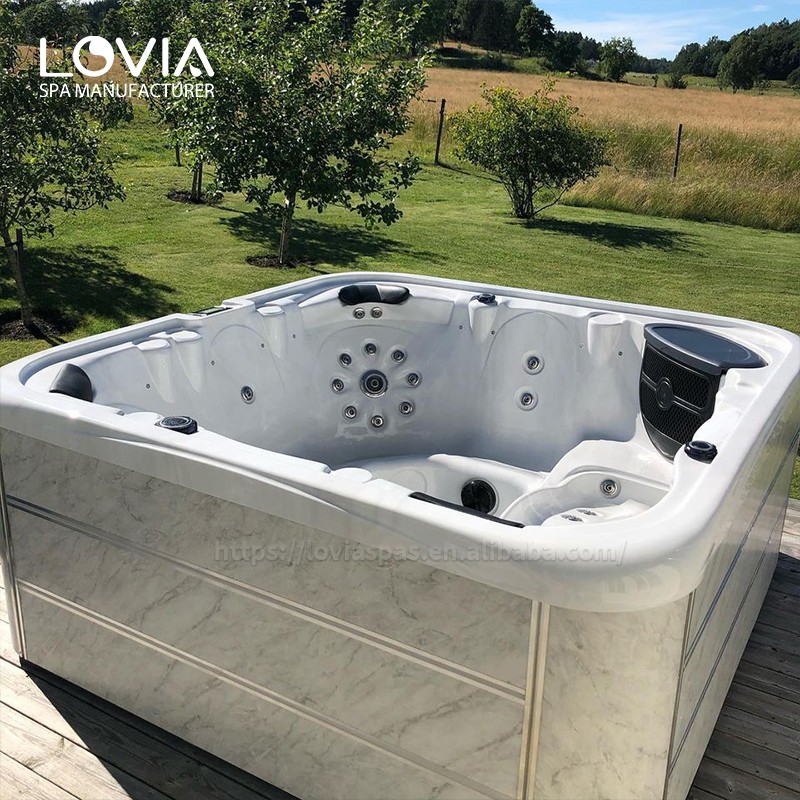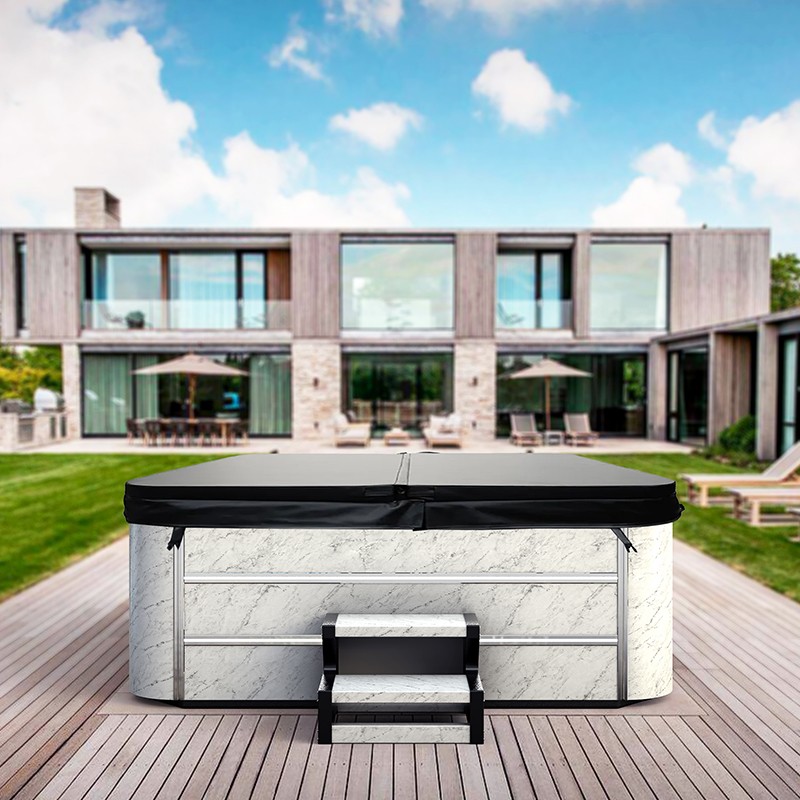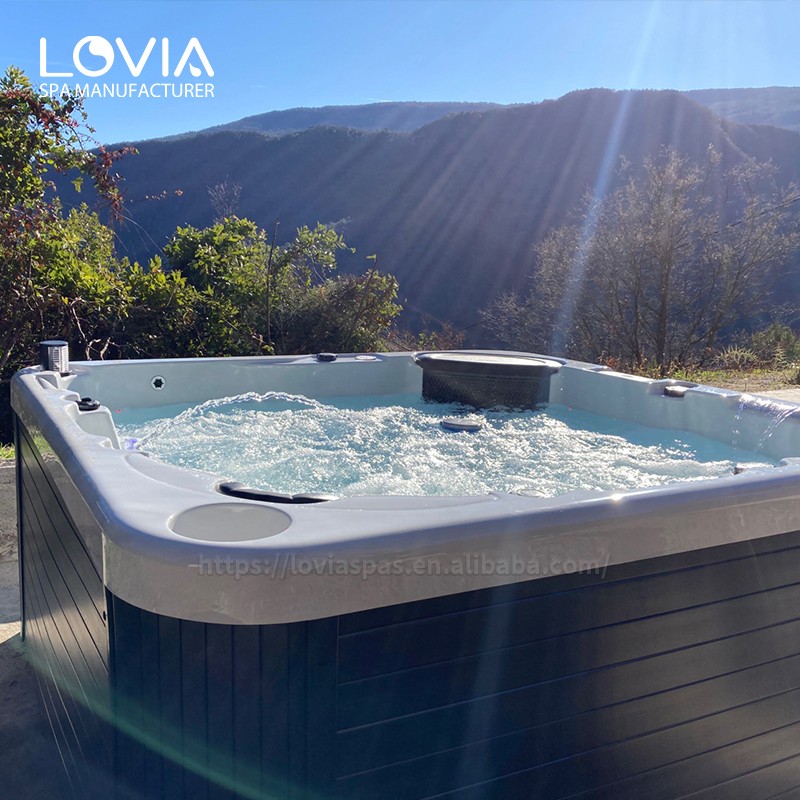
Can you use hydrogen peroxide on an acrylic spa tub?
2025-06-24 15:30Hydrogen peroxide (i.e. hydrogen peroxide) is a mild and environmentally friendly oxidative disinfectant that is gradually being introduced into the cleaning process of home spa equipment.
But the question arises: Is hydrogen peroxide suitable for use in acrylic spa tubs? Are there chemical risks such as corrosion, discoloration, and cracking? Are there any negative effects on the structure, surface, and system of the bathtub? How should its concentration, method, and frequency of use be controlled?
This article will explore this issue in depth from multiple dimensions such as chemical properties, material compatibility, acrylic spa tub structure and composition, disinfection mechanism, and safety standards, and provide users with clear and scientific guidance to avoid damage to the bathtub or endanger the health of users due to misoperation.

Structure and material of acrylic spa tub
In order to determine whether hydrogen peroxide is suitable for acrylic spa tubs, the basic structure and material composition of acrylic spa tubs must first be clarified.
1. Surface material-PMMA (polymethyl methacrylate)
The main surface material of acrylic spa tubs is PMMA, which is what we usually call "acrylic". This material is widely used on hot tub surfaces for its excellent transparency, thermal stability and chemical resistance. Its properties are as follows:
·Good resistance to neutral or weak oxidizing chemicals;
·Moderate heat resistance, with an upper limit of about 80~90°C;
·Afraid of strong alkalis, strong oxidants, and aromatic hydrocarbon solvents.
2. Support layer material
The acrylic layer of an acrylic spa tub is usually very thin (about 3mm~8mm), and is often compounded with a fiberglass reinforced resin (FRP) or PU foam support layer underneath to enhance the overall structural rigidity. These materials are slightly less resistant to chemicals than the surface layer.
3. Other components
Acrylic spa tubs also include nozzles, water pumps, hoses, seals, etc. These parts are mostly made of stainless steel, PVC, EPDM or ABS, and their compatibility with hydrogen peroxide varies.
Therefore, when evaluating whether an acrylic hot tub can use hydrogen peroxide, one should not only consider the reaction of the acrylic surface itself, but also pay attention to the overall chemical resistance of the system.

What is the effect of hydrogen peroxide on acrylic hot tub?
1. Basic properties of hydrogen peroxide
Hydrogen peroxide (H₂O₂) is a common oxidizing liquid. The pure product is a colorless, transparent liquid with a pungent odor. It is often used for household and medical disinfection as a 3% solution.
Its main chemical characteristics are as follows:
· Weakly acidic (pH is about 4.5~6);
· Strong oxidizing (can decompose to release monatomic oxygen);
· Chlorine-free, no residual toxic byproducts;
· Easily decomposed to produce oxygen and water when in contact with organic matter.
2. Analysis of the effect of hydrogen peroxide on acrylic materials
According to a number of material chemical compatibility studies, acrylic materials (PMMA) show good stability when exposed to low concentrations and short-term hydrogen peroxide (<10%). The specific impacts are as follows:
· At low concentrations (≤3%), short-term contact will not cause yellowing, cracking or softening of the acrylic hot tub;
· Concentrations higher than 10% or long-term contact (>24 hours) may cause stress cracks on the surface of the acrylic hot tub;
· At high temperatures (>40°C), the reaction rate is accelerated, and the risk of damage to the acrylic hot tub increases.
Therefore, the conclusion is: hydrogen peroxide can be used for cleaning and disinfecting acrylic spa tubs under controlled concentrations and usage methods.

Application scenarios of hydrogen peroxide in acrylic spa tubs
1. Used as a water disinfectant
During the use of acrylic spa tubs, in order to prevent the growth of microorganisms such as bacteria, fungi, and algae in the water circulation system, users can add diluted hydrogen peroxide to the water.
·Recommended concentration: 3% solution is diluted to control between 50~100ppm;
·Filling frequency: every time the water is changed or the acrylic hot tub is used;
·Filling method: can be introduced through the water pump circulation system to ensure comprehensive distribution;
·Precautions: avoid mixing with chlorine disinfectants to prevent chemical reactions from releasing harmful gases.
2. Used for pipe system flushing
The pipe part in the acrylic spa tub is prone to biofilm, and regular use of hydrogen peroxide flushing helps to maintain internal cleanliness.
·Method: After adding an appropriate amount of hydrogen peroxide, turn on the circulation system for 10~15 minutes;
·Temperature control: The water temperature does not exceed 35°C to avoid accelerated reaction and foam accumulation;
·Flushing frequency: It is recommended to be once a month or more frequently depending on the density of use.
3. Used for surface disinfection of acrylic hot tub
For the surface of the acrylic spa tub, a sprayer can be used to spray 3% hydrogen peroxide solution for light wiping to kill attached bacteria.
·Do not use concentrated liquid to wipe directly;
·Avoid using steel wool or hard brush to scrub to avoid scratching the surface;
·Rinse the surface thoroughly with clean water after use to prevent residual dryness.
Potential risks of hydrogen peroxide to acrylic spa tubs
Although low-concentration hydrogen peroxide is relatively safe for acrylic spa tubs, it may still cause the following risks if used improperly:
1. Stress Cracking
When there are microscopic scratches or tension concentration areas on the surface of the acrylic hot tub, long-term exposure to the oxidant environment may induce microcracks to expand and eventually form cracks visible to the naked eye.
Preventive measures:
·Check the surface condition of the acrylic hot tub regularly;
·Do not apply high-concentration hydrogen peroxide in hot water;
·Rinse with clean water in time after use to avoid dry residue.
2. Degradation of pump and nozzle materials
Some EPDM seals and PVC hoses may age and become brittle in a long-term oxidative environment, resulting in leakage or sealing failure.
Solution:
·Avoid mixing hydrogen peroxide with the system for more than 30 minutes;
·Check the chemical resistance of non-metallic parts in the water pump system every year;
·Consider choosing oxidation-resistant materials to replace parts, such as silicone, FPM, etc.
3. Oxygen release causes foam and pressure fluctuations
The release of oxygen by hydrogen peroxide decomposition may cause foam accumulation and pipeline air blockage in the closed-loop circulation system, causing system pressure fluctuations.
Suggestions for use:
·Disinfect in a static state;
·Turn on the drainage function after 10 minutes of circulation to avoid foam blockage;
·Do not use it in combination with other cleaning agents.

Can it be used? How to use it? How to avoid harm?
Through the systematic demonstration of the above aspects, we can draw the following clear conclusions:
Can hydrogen peroxide be used in acrylic hot tubs?
Yes. Under the conditions of controlling concentration, time and temperature, hydrogen peroxide below 3% is one of the safe and usable disinfectants for acrylic spa tubs.
Recommended use:
| Application | Recommended concentration | Time limit | Precautions |
| Water disinfection | 50~100ppm | 15~30 minutes | Avoid adding in hot water |
| Pipeline circulation cleaning | Within 3% | 10 minutes | Turn on the nozzle circulation, do not deposit in high concentration |
| Surface wiping and sterilization | 3% | Quick wipe | Avoid using in the sun or high temperature |
Prohibited behavior:
·Use of high concentration hydrogen peroxide above 30%;
·High temperature (>40°C) or long time (>1 hour) standstill;
·Mixed with chlorine cleaners;
·Injected directly into the acrylic hot tub circulation system without dilution.
Do you offer packaging customization for brands?
Yes, we provide full packaging customization including logo printing, color schemes, and protective materials for shipment. Our design team works with you to ensure your brand identity is reflected in the final packaging. This service is available for OEM orders and wholesale purchases, allowing you to sell high-quality spas under your own brand with professional presentation.
